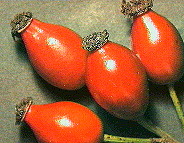

The colours of Christmas are reflected in the red berries and evergreen leaves in the countryside round about us. Hips, haws and holly are among the most familiar of the berries providing the bright flashes of colour in our hedges.
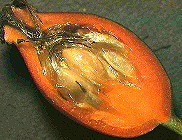 Hips,
the fruit of the Dog Rose (Rosa canina) are pitcher shaped
and about 10-20 mm long (see image right). Inside are a number of
seeds enclosed in a white fibrous material. (see image left).
These fibres are highly irritant and from the image below left,
it can be seen how the colloquial names of "Buckie
lice", "Cow Itches" and "Tickling
tommies" arose from the childhood practice of putting the
hip contents down each others necks! The more usual method of
seed dispersal is by birds. The fleshy fruit is highly attractive
to birds and the prickly seeds are either discarded or pass
unharmed through the bird's digestive system.
Hips,
the fruit of the Dog Rose (Rosa canina) are pitcher shaped
and about 10-20 mm long (see image right). Inside are a number of
seeds enclosed in a white fibrous material. (see image left).
These fibres are highly irritant and from the image below left,
it can be seen how the colloquial names of "Buckie
lice", "Cow Itches" and "Tickling
tommies" arose from the childhood practice of putting the
hip contents down each others necks! The more usual method of
seed dispersal is by birds. The fleshy fruit is highly attractive
to birds and the prickly seeds are either discarded or pass
unharmed through the bird's digestive system.
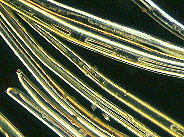 Vitamin
C content of the wild rose hip is higher than any other common
fruit or vegetable. A cup of rose hip pulp provides more vitamin
C than 40 fresh oranges! Rose hip syrup is produced commercially
using farmed "wild" roses. Hips harvested in the
summer, when vitamin C content is at its highest, can be made
into syrup by mincing, stewing and then (VERY IMPORTANTLY!)
straining them through a jellybag, to remove the highly irritant
seeds and fibres. The final stage involves boiling with sugar and
reducing to a syrup.
Vitamin
C content of the wild rose hip is higher than any other common
fruit or vegetable. A cup of rose hip pulp provides more vitamin
C than 40 fresh oranges! Rose hip syrup is produced commercially
using farmed "wild" roses. Hips harvested in the
summer, when vitamin C content is at its highest, can be made
into syrup by mincing, stewing and then (VERY IMPORTANTLY!)
straining them through a jellybag, to remove the highly irritant
seeds and fibres. The final stage involves boiling with sugar and
reducing to a syrup.
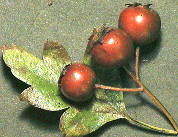 Often
found alongside the wild rose is the hawthorn (Crataegus
monogyna). Another hedgerow plant, (in fact its name derives
from the Anglo Saxon word for hedge, "haga"), its
fruit, the haw, is a more crimson colour than the hip and more
spherical in shape (see left). Instead of four seeds, it only
contains one. Haws too, are rich in Vitamin C.
Often
found alongside the wild rose is the hawthorn (Crataegus
monogyna). Another hedgerow plant, (in fact its name derives
from the Anglo Saxon word for hedge, "haga"), its
fruit, the haw, is a more crimson colour than the hip and more
spherical in shape (see left). Instead of four seeds, it only
contains one. Haws too, are rich in Vitamin C.
The hawthorn has long been considered as having supernatural powers against all types of evil spirits. A variety of hawthorn, the "Glastonbury thorn", which flowers both in winter and again in May has a legend associated with Christmas. The story is that Joseph of Arimathea stuck his dry hawthorn stick into a hill at Glastonbury whereupon it grew and flowered on Christmas day.
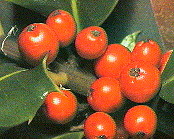 Superstitions
also abound about probably one of the most popular and familiar
of the Christmas plants - holly (Ilex aquifolium). Cutting
a holly tree down was considered to be unlucky, which could
explain the presence of many holly trees in hedgerows in certain
parts of the country today.With its evergreen leaves and long
lasting berries, people associated the holly tree with eternity
and the power to ward off danger.
Superstitions
also abound about probably one of the most popular and familiar
of the Christmas plants - holly (Ilex aquifolium). Cutting
a holly tree down was considered to be unlucky, which could
explain the presence of many holly trees in hedgerows in certain
parts of the country today.With its evergreen leaves and long
lasting berries, people associated the holly tree with eternity
and the power to ward off danger.
Holly's red berries, together with its shiny green spiked foliage are familiar to us all in Christmas decorations and cards. Holly plants are dioecious (either male or female) and it is the female tree which has the berries (as shown left). Each of the spherical berries contains four seeds which are poisonous to humans, but not to birds which eat them and disperse the seeds.
Comments on the article to the author Anne Bruce
Please report any Web problems
or offer general comments to the Micscape Editor,
via the contact on current Micscape Index.
Micscape is the on-line monthly
magazine of the Microscopy UK web
site at Microscopy-UK